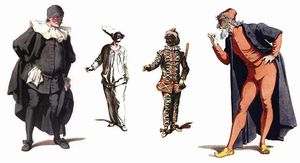From the buffo (funny) character of Arlecchino to the extravagant flirt Pulcinella, the characters of the Commedia dell’Arte have provided entertainment for centuries and their appeal remains strong even today. This form of improvisational theater originated in Italy in the 15th century and diminished as a popular art form by the 18th century but not before leaving its permanent mark on theater. Its several ‘stock characters’ represent stereotypical traits associated with people from various cities across Italy—and they are often symbolic of the cities themselves.
Performance themes revolve around a repertory of conventional theatrical situations, such as adultery, jealousy, old age and love. Dialogue and actions were tailored to become topical and were often adjusted to satirize local scandals, current events, or regional tastes, mixed with ancient jokes and punch lines. The general plotline of each piece centers on two young innamorati (lovers) whose love is forbidden by the vecchio, or ‘old’ characters. The skits play upon generational clashes, where characters called zanni help the young couple overcome the taboo of their love affair. Fortunately, more often than not, young love triumphs.
But perhaps the most interesting aspect of the Commedia is its vibrant cast of regional characters. Here’s a closer look at four key players and the towns they represent.

Arlecchino: the stock character of Bergamo
Arlecchino is a poor, illiterate servant from the town of Bergamo, who leaves his home in search of fortune in Venice. As an acrobat and clown, he is the founder of slapstick comedy. The ‘stick’ that gave rise to the term was the baton he used to bash other characters. Arlecchino plays on the stereotype of the self-interested man. Despite his poverty and apparent ignorance, he’s quite cunning and resourceful. Early in its history, Bergamo was under Venetian rule. Arlecchino reflects this power struggle in the sense that he often acts as a servant to rich merchants from Venice. Bergamo also suffered in the shadow of neighboring Milan, and its triumphs were frequently belittled by any true Bergamasco. People from this town were known for constantly struggling to climb up the ladder of material success and economic wealth and were often forced to leave their homeland to seek success elsewhere.
Il dottore: the stock character of Bologna
Il dottore is an aristocrat who travels to Bologna in pursuit of a university degree. He is rolling in ‘old money’ and plays one of the wealthy vecchio characters who forbid the comedy’s lovers to pursue their budding relationship. The doctor, known as a glutton of fine cuisine and good wine, is easily recognizable, thanks to his rotund figure.
Home to aristocrats who freely enjoyed their wealth, Bologna was known as a place where one could easily indulge in the extravagances of life. The city is home to the oldest university in Europe and has always been considered one of Italy’s richest and well-planned urban centers. Over the years, Bologna has earned itself tell-tale nicknames like la dotta (the learned one) and la grassa (the fat one), references to its famous university and its fine cuisine. With his over-indulgence and love of food and worldly pleasures, il dottore character exemplifies the stereotypical Bolognese man.
Pantalone: the stock character of Venice
Pantalone, a rich and miserly merchant, is another one of the Commedia’s vecchio characters. He represents the merchant class of Venice, often employing Arlecchino of Bergamo. He treats his employee cruelly, and his hard-heartedness reminds the audience that throughout history, merchants in Venice were often accused of mistreating the working class. As port city on the Adriatic and undisputed center of power and commerce, the Venetian Republic was well known for its navy and army. It had a reputation for being a city of invulnerable citizens and high-class merchants. Pantalone’s frugal character reflects the island city’s style of dress and holds a mirror up to the Venetian mentality and its stereotypes.
Pulcinella: the stock character of Naples
Pulcinella is a hunchback whose constant pursuit of women provides the Commedia with additional comic relief. He’s associated with Naples and plays on the Neopolitan stereotype of womanizer and prankster. Naples is infamous for its underground economy and is known for being less industrious than its northern counterparts. Its citizens pride themselves on their ability to take it slow and enjoy life. Pulcinella often has his way with women and is both lighthearted and playful in nature. Enjoyed for his good jokes, astute character and incurable charm, Pulcinella’s character is a larger-than-life depiction of the Neapolitan temperament.
Many stage characters have been modeled on the quintessential archetypes of the Commedia. Shakespeare, for example, adopted several of its vivid elements in The Taming of the Shrew, as did Moliere in The Miser. Stravinsky’s ballet Pulcinella was also undoubtedly influenced by these players. Surprisingly, even the rock band Queen has chosen themes and imagery from the Commedia dell’Arte, most notably in ‘Bohemian Rhapsody’ and to create the cover of the album Innuendo. Although the Commedia dell’Arte reached its peak before the 18th century, giving way to other forms of theatrical art, it certainly played a significant role in determining how people perceive theater today.




